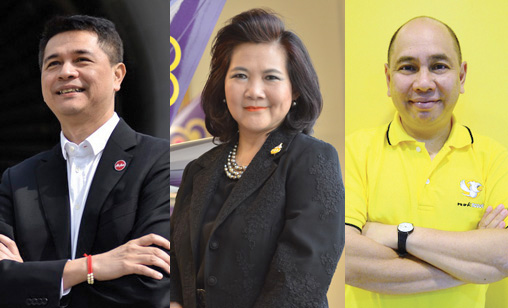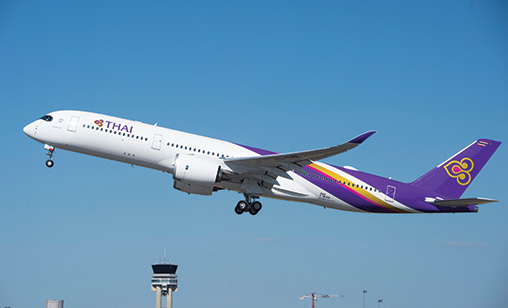News Backgrounder
Thai airlines struggle despite safety upgrade
Restoration of Category 1 status for Thailand’s aviation industry is a significant step forward in the recovery of the country’s regulatory reputation, but Thai airlines will need more than improved credibility to return to profit. Chief correspondent, Tom Ballantyne, reports.
October 1st 2017
Thailand’s airlines are battered and bruised by regulatory missteps, shifting passenger tastes and weak leadership. And there is no doubt there will be more pain ahead. Read More »
Collectively, Thailand’s 21 home grown airlines have been damaged in the minds of passengers by the 2015 imposition of an International Civil Aviation Organisation (ICAO) red flag on Thailand’s aviation regulatory system. But fast growing and fiercely competitive budget carrier expansion has not helped their situation.
 |
The impact on carriers of the industry stigma of the ICAO red flagging has been compounded by extremely low yields and increased fuel and fuel excise costs.
At press time, only Thai AirAsia had reported a profit for the year to date, and its results were much lower than for the same months in 2016.
Top of the list of loss-makers was government controlled Thai Airways International (THAI). It posted a net loss of $157.2 million in its second quarter to June 30, a much larger loss than the $88 million interim deficit of a year ago. For the first six months of 2017, it was in the red for $61.4 million, a reversal of a $93.4 million interim profit 12 months earlier.
Another poor performer, part-owned THAI budget carrier, Nok Air, has announced a second quarter loss of $22.7 million. Full service airline, Bangkok Airways, reported a first half loss of $15.8 million, 365% higher than its year ago loss of $3.4 million.
At Nok Air, a conflicted management situation looks set to be resolved following the resignation of well-connected CEO, Patee Sarasin, from the LCC on September 14. NokScoot CEO, Piya Yodmani, took his place. The top level change was widely believed to have been encouraged by THAI. Patee will remain at Nok Air as board vice chairman but his status as the continuing chairman of NokScoot has yet to be established.
Rival Thai AirAsia, which is the country’s largest LCC, announced a $5.2 million profit for the three months to June 30, a 60% decline over last year. Its income for the six months was $22.4 million, 50% lower than in 2016.
It is difficult to assess the impact of the ICAO ruling on individual airlines, but there is no doubt it made life tough for Thai carriers. After the red flag was raised, some countries put limitations on operations by Thai airlines and also conducted safety audits on their aircraft. China, a key market for Thai carriers, allowed existing schedules to continue but barred flight launches.
The red flag is expected to be removed by year end, following a new ICAO safety audit scheduled for the last week of September. The restoration of category 1 ICAO status will lift network, capacity and equipment restrictions for all airlines issued with re-certification of Air Operator Certificates.
Nine airlines held re-certified AOCs at press time. They are Bangkok Airways, New Gen Airways, Nok Air, NokScoot, THAI, Thai AirAsia, Thai AirAsia X, Thai Lion Air and Thai Smile Airways.
Civil Aviation Authority of Thailand (CAAT) director, Chula Sukmanop, said the flaws in the country’s aviation regulatory oversight system raised by ICAO have been addressed, including the amendment of laws related to the re-certification of Air Operator Certificates (Re-AOC) to airlines.
The CAAT and the Transport Ministry expect to receive the official results of ICAO’s latest audit next month. Chula said the CAAT planned to complete the process of re-certifcation of the remaining 12 effected airlines by January 31 next year.
Signing off the AOC re-certification is considered fundamental to the CAAT’s efforts to restore Thailand’s aviation safety standing.
But uncertainty still clouds the industry in Thailand. Apart from the resignation of Nok’s Sarasin, THAI has been run by an acting president, Usanee Sangsingkeo, since January this year after former president, Charamporn Jotikasthira, completed his contract at the airline.
The failure to appoint a permanent president does not help Usunee’s efforts to address many of THAI’s perennial problems of underperforming staff and fleet and equipment mismatches.
THAI’s latest loss, in the second quarter to June 30, was reported despite a 9.6% increase in revenue year-on-year, to $1.37 billion. Passengers carried jumped by 14.9% and load factor improved by 9%, to 78.5%. However, operating costs rose 8.6%, to $1.4 billion.
The biggest hit to THAI’s bottom line for the reported months were currency losses of $72.6 million, booked losses from the dilution of the airline’s shareholding in Nok Air ($12.9 million) and the impairment of assets and planes ($11.8 million).
Like its peers in the region, THAI is facing a deluge of budget competition. In the first half of this year, LCCs operating in Thailand accounted for 46.2% of all passengers moving through the country’s six main airports, up from 43.9% in the same period last year.
Rising in tandem with passenger growth was the share of flights by LCCs. They operated 47.6% of overall aircraft movements recorded from January to June compared with 43.7% in the previous period.
Figures from Airports of Thailand (AoT), which runs big Thai airports such as Suvarnabhumi and Don Mueang in Bangkok, revealed LCCs increased their passenger numbers in the first half of the year by 13.7%, to 30.5 million. Budget passenger expansion also showed robust double-digit growth both internationally and domestically at 14.1% and 13.5%, respectively, to 10.9 million and 19.6 million.
There is no sign of this trend abating, although THAI’s negative results are not stopping it from developing its network and fleet. THAI’s Usanee said the airline will fly four times a week between Bangkok and Vienna from November and is to take delivery of five new planes - three Airbus A350-900XWBs and two Boeing B787-9s. It also will decommission two of its A330-300s by year end.
The company is taking part in the development of the U-tapao airport, with the goal of making it the most modern aviation repair hub in Asia-Pacific, she said.
 |
But the low-cost airline army is continuing to expand and if ICAO’s red flag is removed and the aviation industry is restored to Category 1 status, they will launch plans for massive expansion in China. It is a market where passenger traffic has been slow to recover after a well-publicized Thai/China zero-dollar tour scam was broken up two years ago.
Nok Air has announced it would launch its China campaign with new charter flights; a critical element of its turnaround strategy. The cash-strapped LCC will add ten China routes this month. The Chinese cities of Yinchuan, Baotou, Linyi, Yichang, Nanchang, and Haikao will be served non-stop from U-tapao, where only a handful of commercial airlines now operate, and charter routes from Bangkok’s Don Mueang will fly to Zunyi and Changsha. Other new destinations on Nok’s radar are the Philippines and India.
Thai Lion Air (TLA), associated with Indonesia’s Lion Air group, is stepping up its operations. It flies B737s, but in November it will take delivery of its first A330-300, with two more of the type arriving at the carrier in December.
TLA CEO, Aswin Yangkirativorn, said the aircraft primarily will be used to launch regular services from its Bangkok Don Mueang base to China, Japan and South Korea. Traffic rights have been acquired to fly to Shanghai and the airline has applied to add Beijing to its network.
THAI’s subsidiary, THAI Smile, is increasing Phuket-Guangzhou and Phuket-Shanghai from this month by four and seven flights a week, respectively. It also will offer more frequency elsewhere in China. Bangkok-Zhengzhou will shift up from five to seven flights a week, Bangkok-Changsha from four to seven a week and Bangkok-Chongqing from five to seven times a week.
THAI Smile acting chief executive, Wiwat Piyawiroj, said expanding its Chinese network would cash in on Thailand’s prime source of tourists. The Tourism Authority of Thailand predicted 10 million Chinese will visit the country this year, up from eight million in 2016.
One relatively new entrant into the market is privately-owned New Gen Airways, which operates a “scheduled charter model”. Established in 2013, it is 51%-owned by a Thai maintenance, repair and overhaul (MRO) company and 49% by two Chinese travel agents based in Shanghai and Shenzhen.
The carrier moved into the black a year after it was launched. In each of the last two years, it has reported profits of more than $150 million. New Gen chief executive, Jarupong Sornprasit, recently said the scheduled charter model allowed it to stay away from the fierce price war at airlines in Thailand.
New Gen sells 100% of its tickets to travel agencies, which is unique among Thai carriers. It results in less exposure to competition, Jarupong said, especially as local airlines are losing market share to deep-pocketed foreign carriers. New Gen flies Chinese tourists to Thailand from 26 secondary cities on the Mainland with a fleet of 12 B737s
The fierce competitive environment has had a disastrous effect on airlines like Nok Air, a situation that will only intensify, as Singapore Airlines, Emirates, Etihad and Lufthansa increase flight frequencies to Thailand in response to growing demand from European, American and North Asian travellers, he said. “Our business model has kept us above the price war,” he added.
THAI is committed to moving ahead with plans to ensure long-term profit growth, Usanee said. Its rehabilitation plan calls for the carrier to lower expenses and boost revenue.
She said the plan will focus largely on product and service improvement, fleet and network management, revenue and cost management, new investment and human resources.”
The new chief executive of Thai budget carrier, Nok Air, has immediately set about turning the struggling airline around. Piya Yodmani, who took over last month from Patee Sarasin, said: “My preoccupation is to stop the bleeding and ensure the business turnaround plan is brought to fruition as soon as possible.” Patee’s departure was no surprise to industry observers. He had run the carrier since it was launched 14 years ago, although his relations with senior executives at Thai Airways (THAI), a 21.57% shareholder in Nok, often were turbulent. Patee will remain on the Nok Board and will serve as vice chairman. Piya was chief executive of the long-haul budget carrier, NokScoot, part-owned by Singapore Airlines. He has resigned from that position to devote his full attention to the task ahead at Nok. He said important priorities were restoring staff morale and building consumer confidence in the airline. In the last two years, Nok has had several damaging periods, including cockpit crew shortages after a mass exodus of pilots from the LCC in February 2016. The dispute caused outrage with passengers whose flights were frequently delayed or cancelled. The airline has suffered combined losses of nearly $150 million since 2014. Piya would not commit to a specific time frame for returning Nok to profit. He said it would be a breach of SET (Stock Exchange of Thailand) rules, but he stressed he was eager to see it happen soon. One of his first announcements was Nok’s deferral of eight new B737 Max 8 jets and the decision to phase out seven existing aircraft to reduce the capacity of the fleet. Nok and Boeing have agreed the new planes will arrive at Nok a year later than originally scheduled. The seven retirements will save aircraft leasing costs. Nok Air wants to raise the utilisation of its aircraft to an average of 11 hours a day from the current eight hours. Piya’s arrival at Nok has encouraged THAI to support a proposed $51.4 million share sale to raise funds for the airline. THAI would take up 245 million shares for $11.1 million. THAI appeared to have accepted the new CEO’s business recovery plan to give Nok one final chance to succeed. |